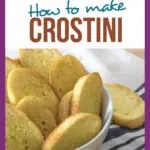How to Make Crostini: Tips, Troubleshooting, and Toppings
Learn how to make crostini that’s crisp on the outside and tender on the inside. These little toasts are ready in 15 minutes and are perfect for loading up with unique toppings or serving alongside your favorite dip! This post includes troubleshooting tips and topping ideas.
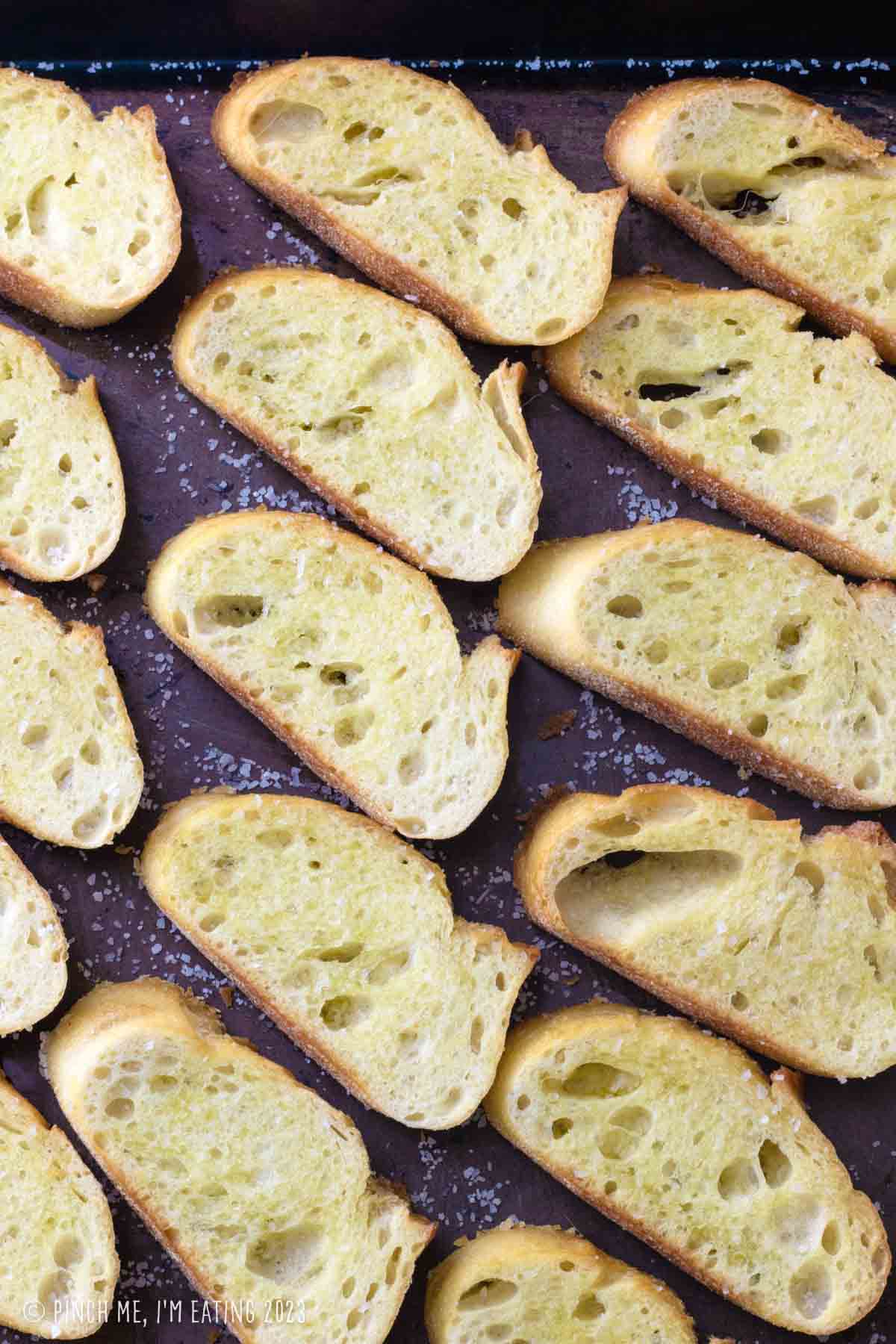
Forget Taco Tuesdays: How about TOAST Tuesdays? Can we please make this a thing? We all need a little more crostini in our lives, and we need it NOW!
I think crostini is the best thing since… sliced bread. I could seriously eat crostini every week and never get tired of it. You can mix up the toppings every time and never have the same one twice if you wanted.
What are crostini?
Crostini are small, thin slices of bread (usually a baguette or similarly-shaped Italian loaf), toasted or grilled until crisp and golden brown. These crispy bread slices make the perfect base for almost any crostini toppings or spreads and make a truly delicious appetizer!
They’re also a must alongside a cheese and charcuterie board, and make a perfect dipper for your favorite dip. (Try my baked spinach artichoke dip with crab for a real treat!)

Crostini vs. Bruschetta: What’s the difference?
Both crostini and bruschetta refer to thin, crisp slices of bread, topped with a savory topping. The main difference is size and cooking method. Crostini are small and toasted in the oven, while bruschette (the plural of bruschetta) are larger and grilled. You can read more about crostini vs. bruschetta here.
Ingredients
How to Make Crostini
Essentially, crostini is just toasted bread, so making it couldn’t be simpler. To make this easy recipe, just slice a baguette or other long, narrow loaf of bread, brush some good olive oil on both sides of the bread, sprinkle one side with kosher salt, and toast it in the oven.
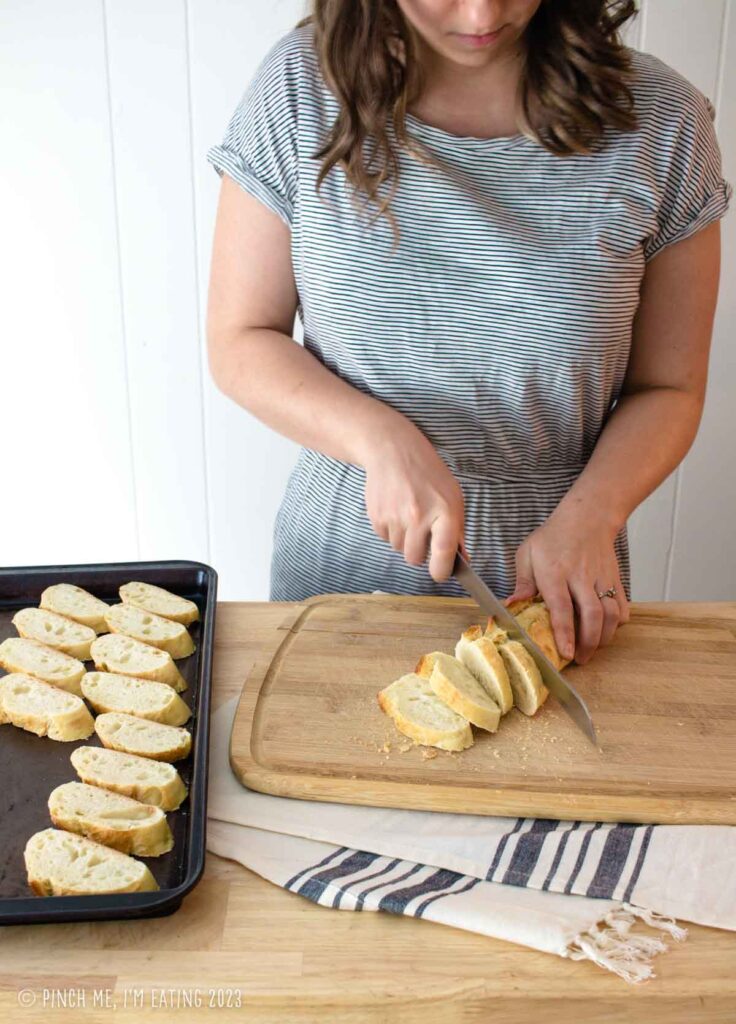
Step One: Slice a baguette.
Use a serrated knife to slice your bread into pieces about a half inch thick (I use my index finger as an approximate measurement for the thickness of the bread). Slice perpendicular to the loaf for small pieces or at an angle for larger pieces. Lay the bread slices in a single layer on a sheet pan.
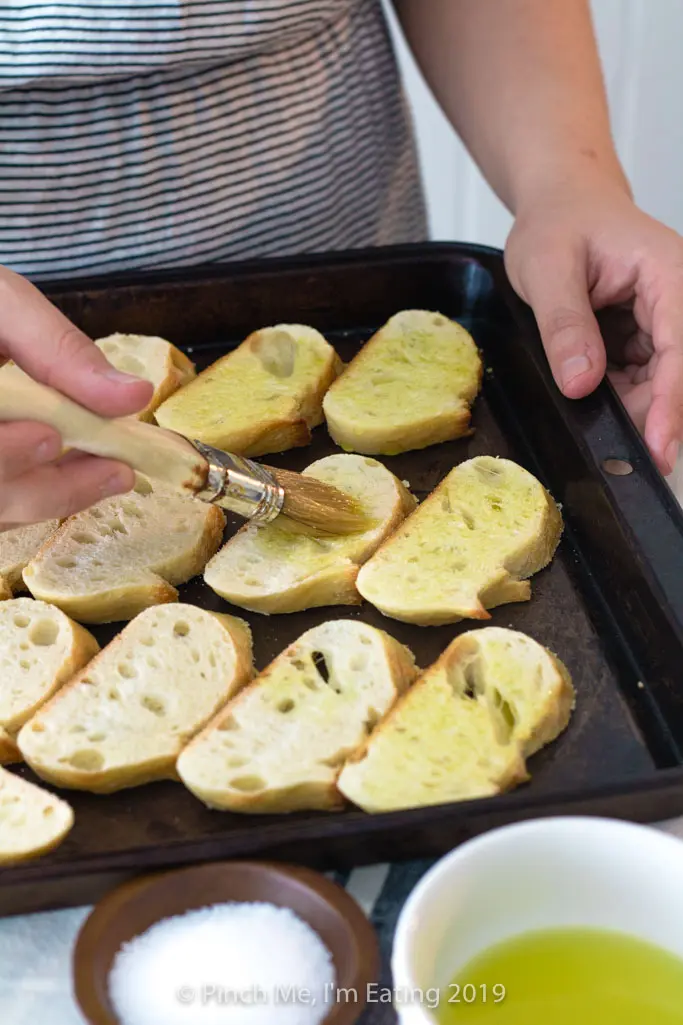
Step Two: Brush with olive oil.
Use a pastry brush to brush both sides of the bread with olive oil. (One side is okay too if you’re in a hurry.) Sprinkle with kosher salt. For garlic bread crostini toasts, sprinkle with a bit of garlic powder as well.
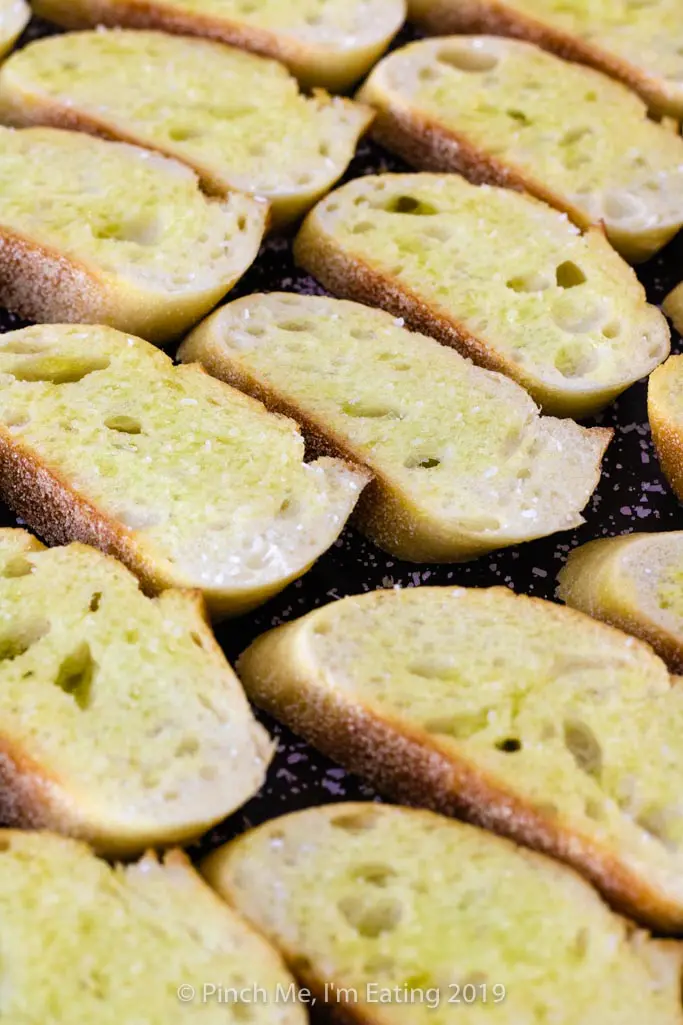
Step Three: Toast.
You can choose your time and temperature based on your desired end result, or based on what else you may have going in the oven at the same time.
- Bake at 425 for 6-8 minutes: Crispy on the outside, tender on the inside. Best for most uses. The preferred option for my husband and me.
- Broil for 2-3 minutes per side: Yields similar results to the 425 method, but you have to keep a close eye on it to prevent burning.
- Bake at 375 degrees for 8-10 minutes: Crispier throughout, like a crouton. Best for more moist toppings or with soup.
Storage
You can make your crostini several days in advance and store them in an airtight container or ziplock bag at room temperature until you’re ready to use them. Make sure you wait until they’re fully cooled before sealing them up, or they will soften and you’ll have to re-crisp them in the oven! Don’t refrigerate them, either, or they will taste a bit stale when you go to eat them later.
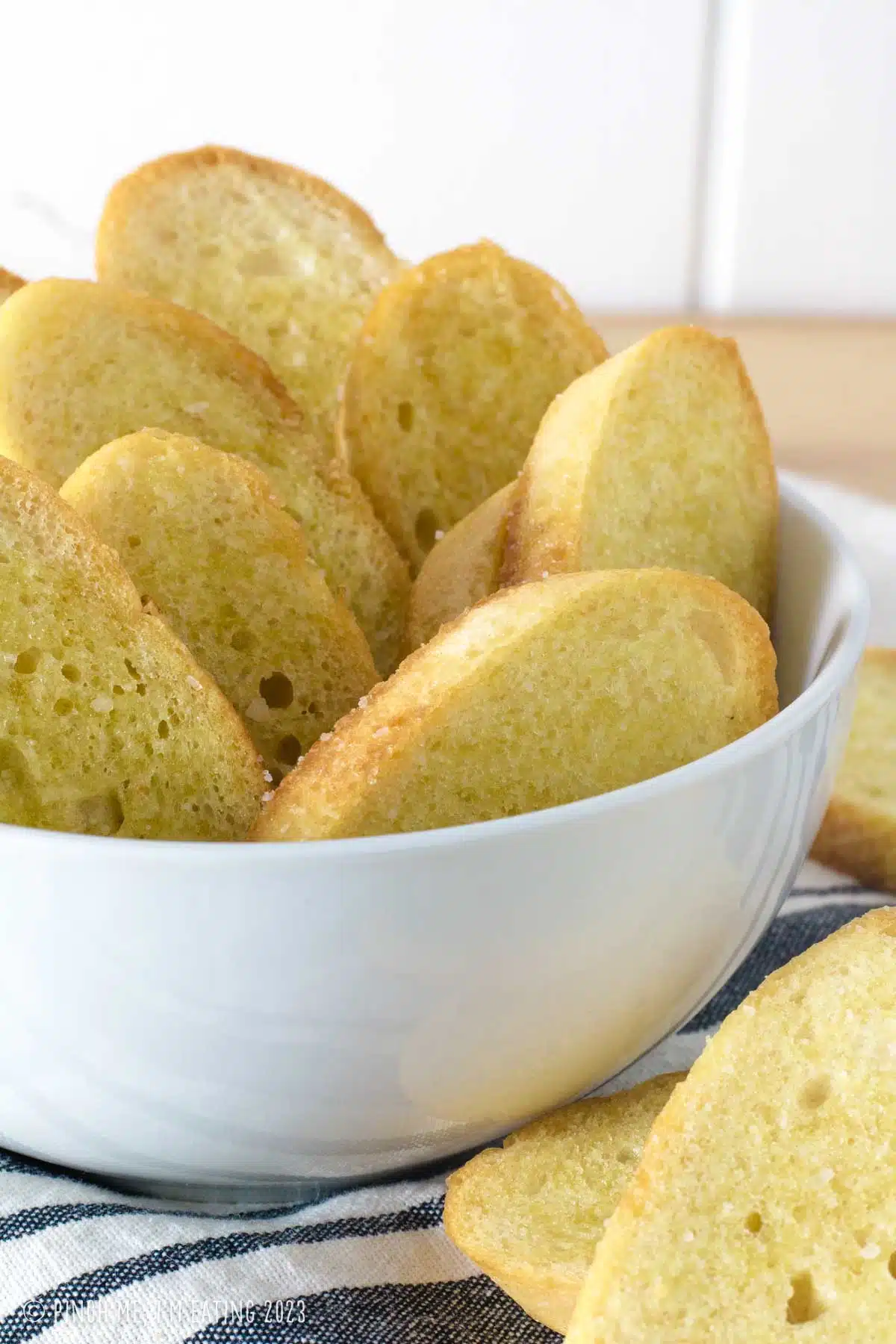
Freezing Crostini
While crostini doesn’t take much time to prepare from fresh, prepping and freezing it can be beneficial for making either large amounts or small amounts.
If you need a bunch for a big party, slicing and oiling several baguettes in advance will save time the day of your event.
Conversely, if you like to have just a few before a date night dinner at home, you can slice, prepare and freeze a whole baguette. Then, when you want crostini, you can pop 6-10 frozen slices in the oven. You can get 3 or 4 appetizers out of a single baguette this way without worrying about your bread going stale.
To freeze crostini: Slice your bread, brush with olive oil, and then freeze unbaked in a freezer bag.
To prepare your crostini from frozen: Lay the frozen slices in a single layer on a sheet pan. Salt and bake them in a preheated oven as if you were preparing from fresh. You may need to add an extra minute or two to the baking time.

Expert Tips & Tricks
- Bread thickness: Slices should be sturdy but thin enough to keep the focus on your toppings. Too thin and you’ll end up with a cracker or a crostino that’s too delicate. Half an inch thick is the sweet spot.
- Topping tips: Don’t overload your crostini! Crostini should be balanced and able to be eaten with one hand.
- Preventing soggy crostini: Be sure to use a slotted spoon to drain off any excess liquid before topping your crostini with something moist like tomato salad.
Troubleshooting
If your baguette has gone stale and hard: If you’re using a crusty bread like a French baguette and it’s become too hard to cut or bite into, there’s a clever and rather surprising hack that I’ve used before.
Preheat your oven to 300 degrees. Then, run the baguette briefly under cool, running water. Then place it on a baking sheet and bake for 6-10 minutes. Your formerly stale bread is like a freshly baked loaf!
It totally freaked me out the first time I tried it but it really works! The water rehydrates the bread and creates the steam needed to make your baguette fluffy again.
If your baguette is already cut, you can still use this trick, but avoid saturating the cut end of the loaf.
Preventing overtoasted crostini: Toasting your bread for too long or at too low of a temperature will dehydrate your crostini more than just toasting on the surfaces. This creates tooth-cracking croutons that are far too crispy to be enjoyable, and will leave your guests with flakes and crumbs of bread down the fronts of their shirts, aka “bread dandruff”. What a name, right?
Cooking at a higher temperature for a shorter time or even putting it under the broiler (keep a close eye on it if broiling!) will help keep this from happening.
Dealing with overtoasted crostini: If your crostini did end up too crunchy, you can put a moist topping on it (like diced tomatoes or pesto) and let it sit for a while to soften. Crouton-like crostini is also a great candidate for topping French onion soup.
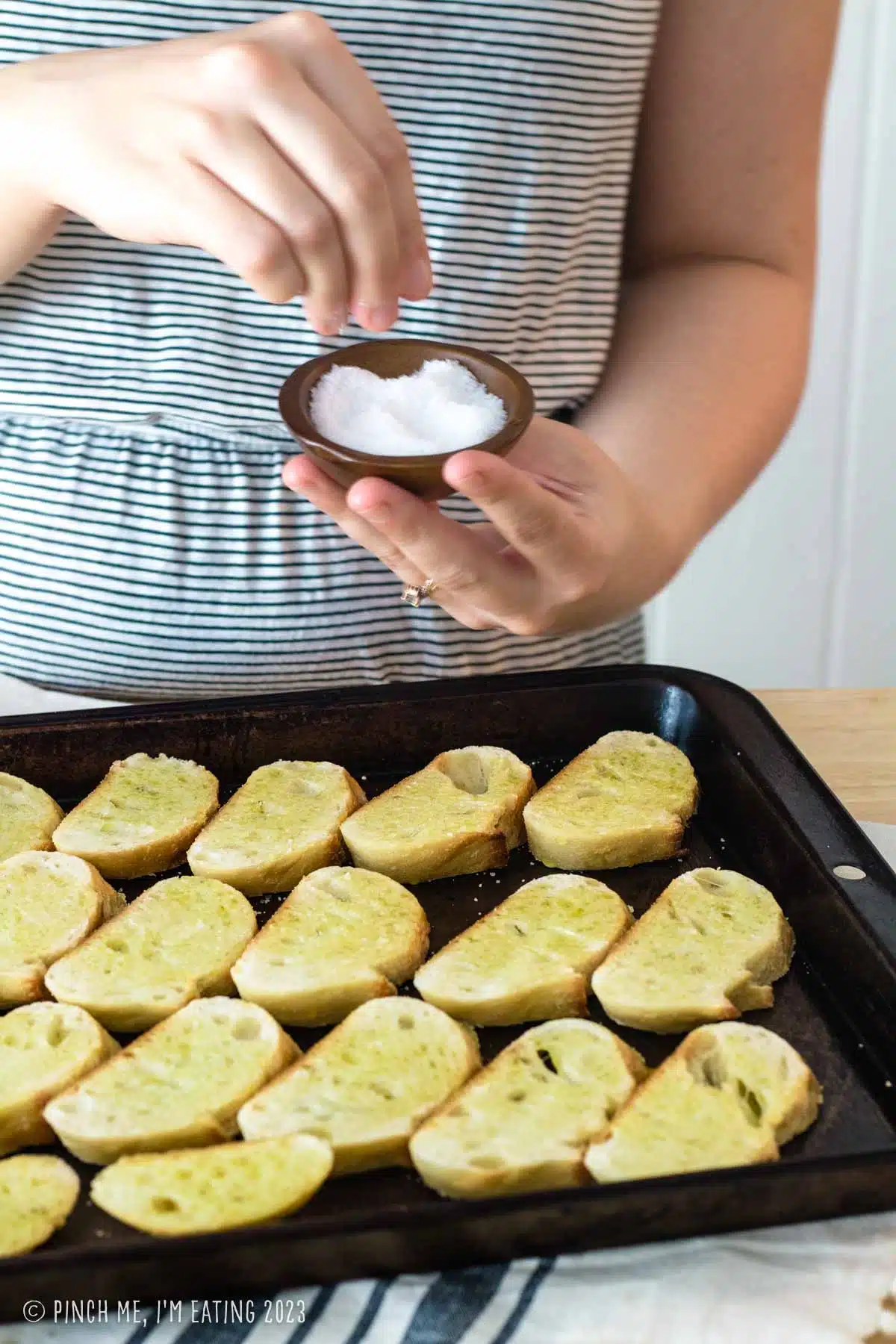
When to serve homemade crostini
- Party food: Crostini make great party appetizers. You can either pick one or two topping combos and serve your crostini canapes pre-assembled, or lay out several toppings as a crostini bar.
- As a date night appetizer: Serving crostini appetizers at home is a great way to elevate a simple dinner to “date night in” status. As an appetizer for two, you can bake 8-10 slices and freeze the rest unbaked for another night.
- As a simple snack for company: I love having something for a few guests to nosh on while we catch up and have some wine. Keep some unbaked crostini in the freezer and a jar of tapenade in the pantry for a quick and impressive snack. Set out some crostini, tapenade, and a spreadable soft cheese (like cream cheese or goat cheese) on the coffee table and let your guests assemble it themselves!
Easy crostini toppings
- Classic tomato bruschetta
- Caprese style: Fresh tomatoes, mozzarella, fresh basil, and balsamic vinegar
- Fig and Olive Tapenade with Cream Cheese and Walnuts
- Goat cheese and olive tapenade
- Boursin cheese and blueberry caramelized onion jam
- Chicken liver pate
- Southern Pimento Cheese
Crostini appetizer recipes
Looking for ideas of how to top your crostini? Here are a few crostini appetizer recipes to take your canapé game to the next level!
Hungry for even more crostini recipes? Check out these
52+ Showstopping Crostini Recipes to Make This Year!
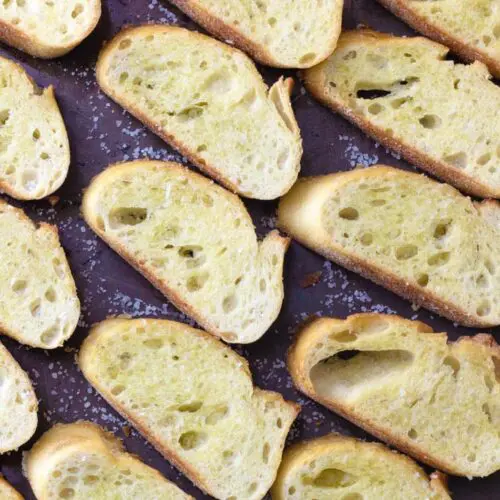
How to Make Crostini (Easy 15-minute recipe)
Ingredients
- 1 long narrow loaf of bread such as a baguette, Italian or French loaf
- 1/3 cup olive oil
- kosher salt
Instructions
- Preheat oven to 425 degrees. Cut loaf of bread into slices 1/3 to 1/2-inch thick. I use my finger as an approximate measurement – somewhere between pinky-width and index-finger-width is a good thickness for a slice for me (I have smallish hands). For smaller slices, cut in straight slices; for larger slices, cut diagonally.
- Lay out slices on a large baking sheet and brush both sides with olive oil. Sprinkle lightly on one side with course kosher salt.
- Bake for 6-8 minutes. Outsides should be crispy but inside should still have some chew. The center should have a little spring to it when you push down.
- Serve with a cheese board, dip, or tomato or French onion soup, or top with your favorite crostini toppings.
- To store: Wait until cool, then store for up to several days in an airtight ziplock baggie at room temperature. Crostini will soften if you seal it while still warm or taste stale if you refrigerate it.
- To make ahead and freeze: Cut and oil slices, then freeze, storing in a zip-top freezer bag. Preheat oven, sprinkle crostini with salt, and bake as if preparing from fresh.








